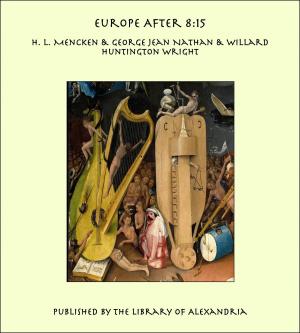The History and Romance of Crime: German and Austrian Prisons, Prisons of Prussia, Bavaria, Saxony and Austria-Hungary; the Fortresses of Magdeburg and Spielberg
Nonfiction, Religion & Spirituality, New Age, History, Fiction & Literature| Author: | Arthur George Frederick Griffiths | ISBN: | 9781465606679 |
| Publisher: | Library of Alexandria | Publication: | March 8, 2015 |
| Imprint: | Language: | English |
| Author: | Arthur George Frederick Griffiths |
| ISBN: | 9781465606679 |
| Publisher: | Library of Alexandria |
| Publication: | March 8, 2015 |
| Imprint: | |
| Language: | English |
Interest in penal matters in Germany and in Austria-Hungary centres rather in the nature and number of persons who commit crimes than the methods pursued in bringing them to justice or the places in which penalties have been imposed. The character and extent of crimes committed from time to time, attracts us more generally than the prisons designed and established for their punishment. This is the more marked because such prisons have not achieved any remarkable prominence or notoriety. They have been for the most part the ordinary institutions used for detention, repression and correction, more noted for the offenders they have held than their own imposing appearance, architectural pretensions, or the changes they have introduced in the administration of justice. Only in more recent years, since so-called penitentiary science has come to the front and the comparative value of prison systems has been much discussed, have certain institutions risen into prominence in Germany and become known as model prisons. These have been erected in various capitals of the empire, to give effect to new principles in force in the administration of justice. Among such places we may specify a few, such as Bruchsal in Baden; the Moabit prison in Berlin; the prison at Zwickau in Saxony; the prisons of Munich and Nürnberg in Bavaria and of Heilbronn in Württemberg. To these may be added the prisons of Stein on the Danube, of Marburg on the Drave, and of Pankraz Nusle near Prague in Austria-Hungary. Many others might be mentioned which have played an important part in the development of penitentiary institutions. The conflict of opinions as to prison treatment has raged continuously and as yet no uniform plan has been adopted for the whole German Empire. Each of the constituent states of the great aggregate body has maintained its independence in penal matters and the right to determine for itself the best method of punishing crime. At one time, after 1846, the theory of complete isolation was accepted in all German states, although the means to carry it into effect were not universally adopted. Reports from the United States had deeply impressed the authorities with the merits of solitary confinement, among others the well known Professor Mittermaier, one of the most notable judicial authorities of his time. But reaction came with another no less eminent expert, Von Holtzendorff, whose works on prison administration are still held in great esteem. After visiting Ireland, he was won over to the seeming advantages of the progressive system, the gradual change from complete isolation to comparative freedom, and he strongly favoured the policy of cellular imprisonment. His proposals laid hold of the practical German mind, and to-day the scheme of continuous isolation finds little support; it left its mark, however, in several prisons which will be referred to in the following pages.
Interest in penal matters in Germany and in Austria-Hungary centres rather in the nature and number of persons who commit crimes than the methods pursued in bringing them to justice or the places in which penalties have been imposed. The character and extent of crimes committed from time to time, attracts us more generally than the prisons designed and established for their punishment. This is the more marked because such prisons have not achieved any remarkable prominence or notoriety. They have been for the most part the ordinary institutions used for detention, repression and correction, more noted for the offenders they have held than their own imposing appearance, architectural pretensions, or the changes they have introduced in the administration of justice. Only in more recent years, since so-called penitentiary science has come to the front and the comparative value of prison systems has been much discussed, have certain institutions risen into prominence in Germany and become known as model prisons. These have been erected in various capitals of the empire, to give effect to new principles in force in the administration of justice. Among such places we may specify a few, such as Bruchsal in Baden; the Moabit prison in Berlin; the prison at Zwickau in Saxony; the prisons of Munich and Nürnberg in Bavaria and of Heilbronn in Württemberg. To these may be added the prisons of Stein on the Danube, of Marburg on the Drave, and of Pankraz Nusle near Prague in Austria-Hungary. Many others might be mentioned which have played an important part in the development of penitentiary institutions. The conflict of opinions as to prison treatment has raged continuously and as yet no uniform plan has been adopted for the whole German Empire. Each of the constituent states of the great aggregate body has maintained its independence in penal matters and the right to determine for itself the best method of punishing crime. At one time, after 1846, the theory of complete isolation was accepted in all German states, although the means to carry it into effect were not universally adopted. Reports from the United States had deeply impressed the authorities with the merits of solitary confinement, among others the well known Professor Mittermaier, one of the most notable judicial authorities of his time. But reaction came with another no less eminent expert, Von Holtzendorff, whose works on prison administration are still held in great esteem. After visiting Ireland, he was won over to the seeming advantages of the progressive system, the gradual change from complete isolation to comparative freedom, and he strongly favoured the policy of cellular imprisonment. His proposals laid hold of the practical German mind, and to-day the scheme of continuous isolation finds little support; it left its mark, however, in several prisons which will be referred to in the following pages.















